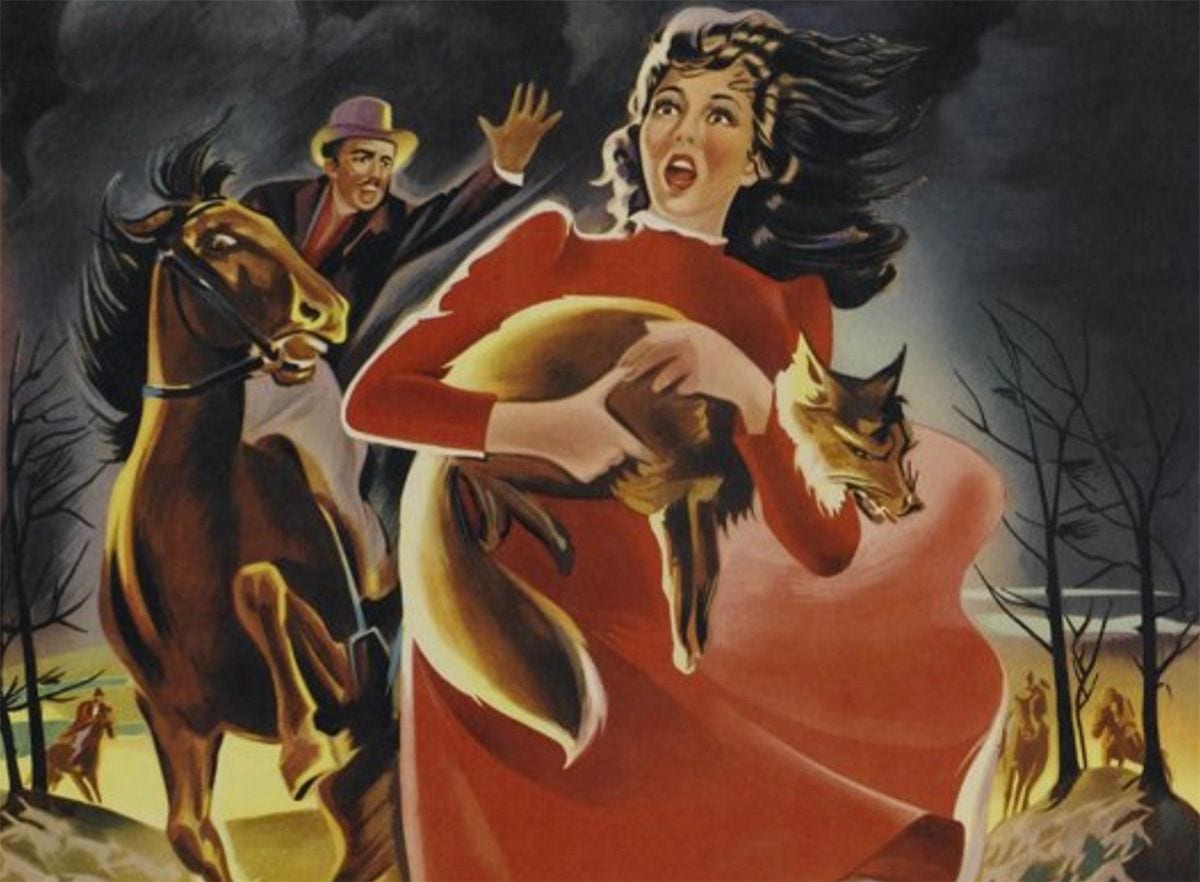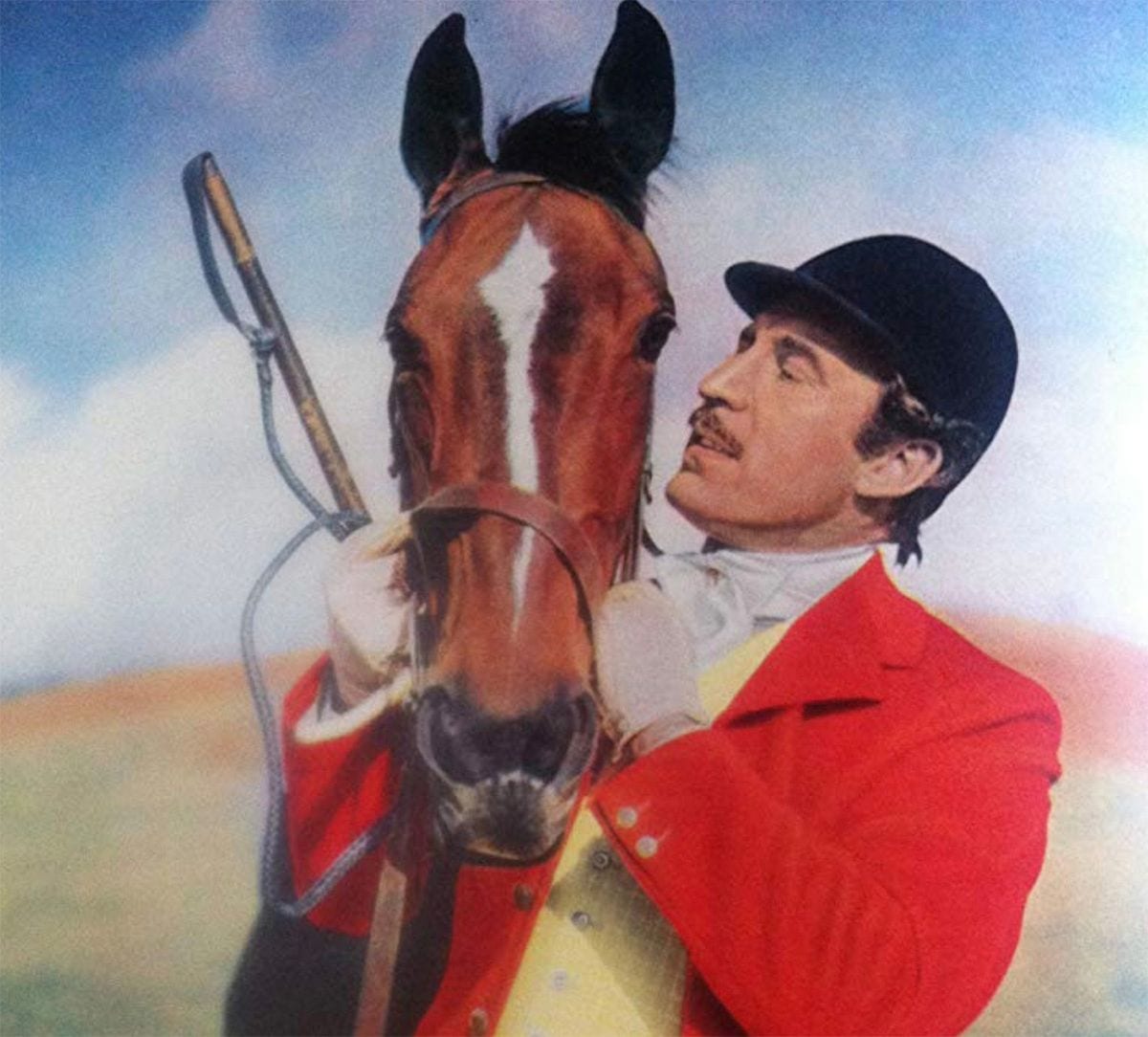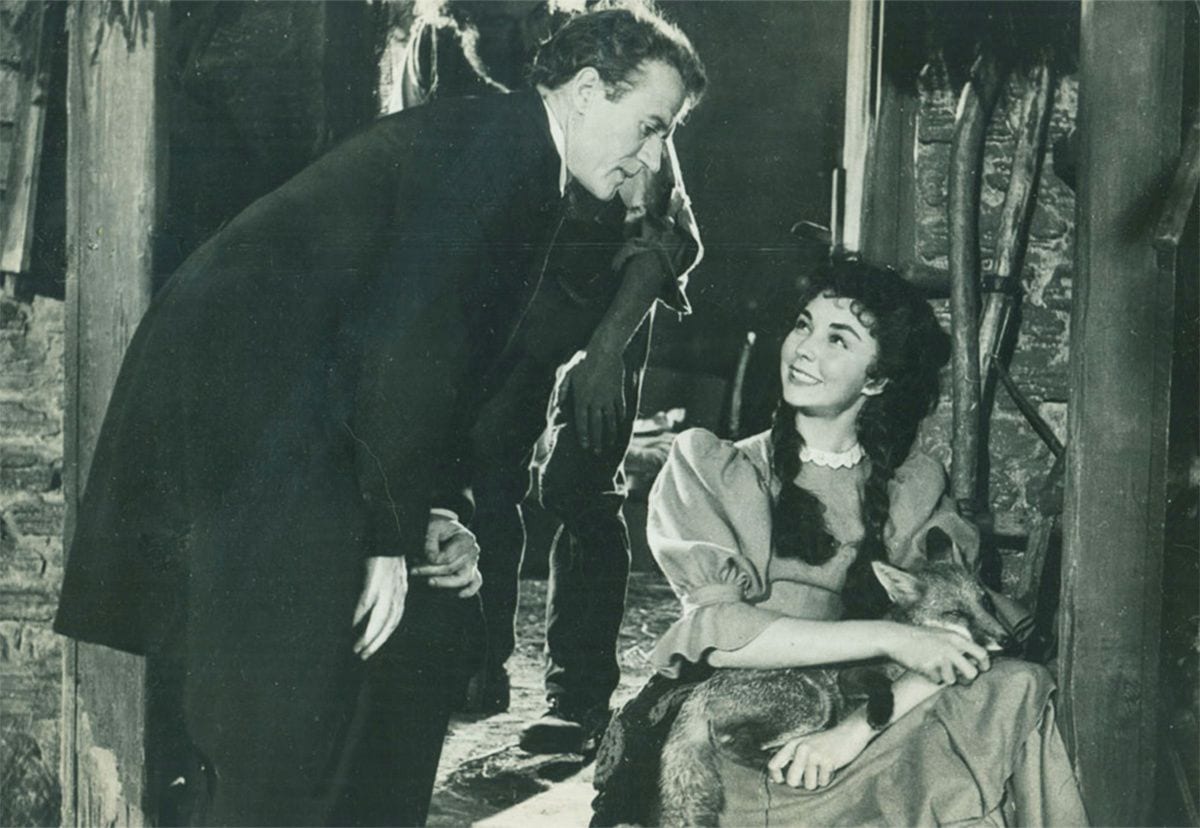
“Seems the world’s a big spring trap and us in it,” says Hazel (Jennifer Jones) to her father, the harpist and coffin-maker Abel Woodus (Esmond Knight), as they stand over an open mineshaft where once a cow and her calf plunged and were turned “all over jelly”. In a sudden seizure of emotion, she can’t bear to look at it. “What came over me is I’ll die as well as the others,” says she, and he responds, “You only just found that out? What a queen of fools you be!”
And then, the very next moment, Hazel’s ear is caught by distant band music and she goes trotting off like it’s catnip. Her father looks after her and pronounces, “You’re too nash. That’s what you be. Nash.” The captions transcribe this as “nice” but I’m not so certain what he means.
Whether you’re watching this scene in Michael Powell and Emeric Pressburger’s Gone to Earth (1950) or in its much shorter US version refashioned by David O. Selznick as The Wild Heart (1952), you can’t help being struck by the cold wind of foreshadowing. This is an impudently symbolic and stylized movie, every shot conceived for ravishing Technicolor, every scene constructed with glorious artifice, every line rich with meaning and foreboding. At long last, both versions are available on one Blu-ray from Kino Lorber, as one more gem from Powell and Pressburger emerges into the digital daylight.
From the emblematic opening scene, Hazel is identified with her pet vixen, Foxy, whom she saves from a hunt at night. When Hazel enters her hobbit-like home, she’s framed in her father’s latest coffin. Has she fled from a real hunt or, as she believes, the superstition of a Black Huntsman who spells death if you dare turn around? Hazel declares herself Foxy’s “mam”, since the animal lost her real mam to a hunt (as Hazel’s mam is lost), and now Hazel keeps it in a household with a rabbit and chickens. As you can guess, the fox constantly reverts to its uncontrollable nature, which includes frequent escapes from its mistress, and all this speaks to parallels with Hazel.
Raised by her cantankerous father after the death of a Gypsy mother, she’s herself a wild creature of the earth who identifies with all things in a pagan, animistic manner. Her very name, Hazel Woodus, evokes “the woods” twice over, one of them witchy, and she reads a book of rhymed charms and spells from her mother, which her father calls “witches’ tales” in The Wild Heart and “old wives’ tales” in Gone to Earth.
She seems to bewitch two men who cross her path. The harsh and growling Jack Reddin (David Farrar) is the local dissolute “gentleman” squire and huntsman who gives her a night’s shelter and, when she escapes his advances and the bribery of fine gowns, “had his trouble for nothing”, as his servant Andrew Vessons (Hugh Griffith) crows.
Coiffured like a large ungainly bird, perhaps an emu, Andrew vows he’ll never serve a mistress. He even declares “Maiden I’ll stay till me dying day,” and he’s symbolized by a topiary swan he’s trimmed out of a yew tree — only lacking the beak. Make of that what symbol you will, though sometimes a beak is only a beak. His avian associations include the shooting of blackbirds, which Hazel claims will make the milk run bloody. When Hazel tells Jack he prefers living with Andrew to living with her, Jack replies, “He has his virtues and you have yours.” At least that’s what he says in The Wild Heart. In Gone to Earth, it’s “he has his uses and you have yours.”
The other bewitched gentleman is the new vicar, Edward Marston (Cyril Cusack), a gentle soul strong in his faith. He comes with a doting mother (Sybil Thorndyke). He marries and baptizes Hazel, but he adopts the position that he’ll “ask nothing of her” until she wants him. The movie strongly implies this as his fatal error, for the question of personal will is very much up in the air in this movie for animals and people, and Jack Reddin has will enough to exert on almost anybody.
Marston is first bewitched by Hazel singing “Harps in Heaven”, whose lyrics declare that the harps played for Christ “with his eyes so blue” and for Peter and Paul “but never played for me at all”. If we’re to take the song as self-expression, it refers less to being in a state of sin and more to the film’s philosophical inquiry into whether animals have souls and to what extent humans are animals.
Jack keeps ordering Hazel to come to him and telling her that she wants to obey. She’s frightened, flattered, and intrigued all at once, and these contradictions are completely credible. She, in turn, leaves things up to spells and rituals learned from her witchery book to guide her in what she should do — as opposed to letting her husband’s book, the Bible, tell her what to do and be guided by its rituals. In The Wild Heart, her ritual involves the wind blowing a shawl on “the Devil’s Throne” (a rock), while Gone to Earth involves walking round it “widdershins” and listening for “fairy music”, which is ambiguously provided by her father’s harp.
These supernatural and philosophical complications and ambiguities explain why Joseph Cotten’s narration, layered over the opening of the Selznick version, attempts to reduce this story’s complexity to a simple morality tale of a “pagan” woman who refused Christian ways and reaped what she sowed — something Americans could understand, apparently. That element’s there or can be interpreted, but the paganism has to do with the earth and nature and the instinct that drives wild things — “something strong as driveth us all” says Hazel, suddenly adopting Biblical cadence, with its implication that a deeper, more natural understanding of Christianity is at work.
Edward represents both civilized will and Christianity, even though everyone else in the parish represents, as he recognizes grimly, “the world”. Yet when he raises his head and speaks to God about Hazel, Powell gives us his subjective view staring up into a giant tree. Is he looking through the branches to the heavens, or is the tree God? It does seem to have a trinity of trunks. If the latter, is Edward also touched by Hazel’s pantheism, which worships nature and puts animals bluntly on a level with humans?
Edward and Hazel have theological discussions when, the scenario implies, they should be indulging in earthly pleasures if he intends to keep her by his side. She insists that God “doesn’t answer creatures caught in traps, cryin’ and screamin’ to be loosed and never a one to hear ’em, and it’s come over me to wonder who’d loose me.” Actually, that speech only occurs in The Wild Heart, with Gone to Earth handling that whole scene quite differently. The Wild Heart also has the only instance of Hazel explaining that God created foxes as mischievous and must have liked his work.
On the topic of marriage, she explains, “Me mam dinna like it. She said tears and torment, tears and torment was a married lot. And she said ‘Keep yourself to yourself. You were-na made for marryin’ any more nor me. Eat in company but sleep alone.’ ” She is pulled in so many directions that she feels helpless before instinct, which is only provided by the rough Reddin, who “has blood on him”. She means the blood of innocent, instinctive, unthinking creatures, and once again draws parallels between them and herself.
This fairy-tale-like story, almost a myth, provides a rich canvas for Powell and Pressburger’s eccentricities and the feeling for fantasy and fable, which runs strongly through their work. Some of their films are outright fantasies and some rather less outright, while even their most realistic works indulge in self-conscious moments of fancy, visual artistry, and gratuitous literacy.
(IMDB)
For example, one of their most realistic films is the 1957 WWII adventure Ill Met By Moonlight, based on W. Stanley Moss’ 1950 memoir of the same title, and we can believe its title quotation from A Midsummer Night’s Dream appealed to the filmmakers as much as the story. The film seems made just for the joy of presenting the Moss character’s subjective shot discovering his Byronic hero (Dirk Bogarde) cutting a fabled figure by the moon. If this is Powell and Pressburger in a docudrama of war, all stops are out when serving up a brew of supernatural signs and spiritual conflicts such as Gone to Earth.
This movie, with its outdoors scenes shot in Shropshire along the Welsh border, continually evokes Druidic or Roman history, while images and dialogue evoke ghosts and spirits and other preternatural forces. The ancient, primitive and wild dominate the tone via gorgeous Technicolor photography by Christopher Challis and his camera operator, future Oscar winner Freddie Francis. The equally bewitching moments of process photography are courtesy of master W. Percy Day. This film glories in the countryside more than any Powell and Pressburger film except possibly the fabulous A Canterbury Tale (1944), and that wasn’t in color.
Brian Easdale’s equally gorgeous score mixes the “pagan” and spooky with Christian hymns, though it’s often held back so we can hear an unusually rich and complex sound design for the period. Exteriors are often “scored” by birds and country sounds, while interiors have as many ticking clocks as an Ingmar Bergman movie. Also of stunning beauty are the interiors and general design by their production designer, Hein Heckroth, working with art director Arthur Lawson. Have we mentioned that this movie is beautiful? It’s beautiful.
This story of 1897 Shropshire was conceived by novelist Mary Webb, who published Gone to Earth in 1917. The script uses enough of her local dialect, as delivered by Jones with sufficient conviction almost to make us forget she’s an imported Hollywood beauty and Selznick’s eternally promoted project, that it’s helpful to have the captions on — or it would be if they weren’t so full of distracting errors. To give only two examples: “lay a Romany shawl” becomes “they roam in a shore”, and “all as you’d lief have” becomes “all as you’d leave half”.
This is Farrar’s third and last film for Powell and Pressburger, and very different from his roles in Black Narcissus (1947, another meditation on the sexual vs. the spiritual in eye-popping Technicolor) and The Small Back Room (1949, a more scaled-back personal drama about disarming bombs and alcoholism). As basically the villain of entitlement and cruelty, Farrar’s Reddin feels like a wholly conceived and often bewildered and reactive character, one who shouts, “I never ran after a woman in my life” before spending half the movie metaphorically running her to ground from horseback. She’s his weakness and he compensates by trying to tame her into a pet or hunting trophy. He’s thwarted by processes he doesn’t grasp, including his own emotions.
David Farrar as John ‘Jack’ Reddin in Gone to Earth (1950) (IMDB)
Cusack made four films for Powell and Pressburger, and he’s excellent as a lover and husband who’s decidedly “weak” in some ways, yet who presents his niceness with a steel backbone of faith that has no trouble disregarding his mother or anyone else in order to claim what he wants, and which he loves more tenderly than Reddin can. If this love is their chief difference, the iron will is their chief similarity. Reddin would kill a fox as vermin; Marston would stroke it and promise to love Hazel as she loves Foxy. In different ways, they’re both setting traps for her that her mother warned her against, and both men are forthright in everything they do and say.
Particularly in Gone to Earth, Marston’s centrality to a series of red-tinted scenes in which he takes on some of Reddin’s qualities (Reddin/redden) shows him capable of anger, cruelty and will. Perhaps Cusack’s strongest moment is when, after Mrs. Marston angrily asks her son what he’s looking at, he gazes almost into the camera with deadly cold blue eyes and says quietly, “The world, mother.” It’s as good as a slap in the face. Dear Reader, this is cinema.
The casting is perfect all around, and it must be stressed that, even though this film existed to serve as another vehicle for Selznick’s promotion of Jones, whom he married in 1949 (the year of filming), she’s fully up to it. Her most memorable roles use her porcelain beauty to evoke an uncanny quality, whether in Henry King’s The Song of Bernadette (1943), King Vidor’s Duel in the Sun (1946) or William Dieterle’s Portrait of Jennie (1948). If she’d made no other movies but those three, her fame would be assured.
This movie, while also wonderful, didn’t shake the US box office, and it’s difficult to guess the extent Selznick’s meddling two-year delay before its American release had on the project. The story was problematic from the get-go because, while English cinema could handle the sexual sophistication of a virgin bride swayed into adultery (even though she’s inevitably “punished” for it), such things were too hot for 1950 Hollywood. Ironically, Selznick felt the need to make the situation more shocking in order to justify the “punishment”, for The Wild Heart is the only version in which it’s declared that Hazel is pregnant with Reddin’s child. That makes the outcome seem ghastlier and causes the production to resonate with Selznick’s production of Alfred Hitchcock’s Rebecca (1940).
Selznick’s tamperings with Gone to Earth, as undertaken with uncredited director Rouben Mamoulian, go beyond renaming it The Wild Heart, cutting it by about half an hour, and fiddling with editor Reginald Mills’ sharp and sometimes explosive transitions. As we’ve indicated, not only are many details cut but dialogue is changed (e.g., dropping Hazel’s comparison of Reddin to Jesus Christ in their first meeting) and whole scenes are reconceived and reshot in Hollywood, with a few moments between Hazel and Reddin having no parallel in the British version.
David Farrar as Jack Reddin and Jennifer Jones as Hazel Woodus in Wild Heart (1952) (IMDB)
Mamoulian has shot these scenes to match the surrounding style, so that Selznick’s changes don’t stick out incongruously and instead make a tantalizing alternate universe. The most unfortunate revision is at the ending, with Hazel clutching a stuffed fox so obvious that viewers must avert their eyes from it to avoid breaking the spell. Powell and Pressburger’s version of that scene emphasizes how Hazel is caught between two men who implicitly collaborate in running this wild thing to earth.
I recommend watching The Wild Heart first, because then Gone to Earth becomes a series of pleasant discoveries of additional texture and detail and shifts of emphasis and tone. The other way around, not so much, and viewers may tend to become annoyed with The Wild Heart if it’s watched second. Some differences in Gone to Earth are major, like the hellish red glow that bathes the climactic confrontations and the more ambiguous and rough nature of those confrontations.
Some details in Gone to Earth are minor but telling, such as the scene where Marston delivers a public prayer in a shot dominated by a maypole, a symbol of pagan holdovers. Powell and Pressburger’s movie consistently poses pagan and Christian mythology and supernaturalism so closely that it becomes hard to tell the difference. One could make a drinking game out of spotting the references to angels and other winged things. At one point, Reddin asks ironically if he looks like an angel, and of course he’s associated with the Black Huntsman and, in the red-tinted and fireplace-framed sequences, even the Devil himself.
I believe one of the most crucial shots in Gone to Earth occurs shortly before the 13-minute mark, almost subliminally. In the moments before Hazel is to meet her huntsman Reddin, the camera zooms into a single feral eye spying on her within some wooden, tree-ish thingamabob. If we make any sense of this unexplained moment, we must fall back on English folklore of the Green Man: a face in the greenery that implies the presence of Pan or a similar pagan deity. This figure’s glimpse — our glimpse of it, its glimpse of Hazel — speaks to the theme of fate vs. will, and choice vs. instinct. Does this figure merely observe Hazel or influence her?
Kino Lorber’s Blu-ray offers both films, with a commentary by Troy Howarth on The Wild Heart and by Samm Deighan on Gone to Earth. The former gives lots of background info on the players while the latter concentrates on themes linking the film to other Powell/Pressburgers and other English films and novels. Having both versions of this film in one place and looking so lovely is a dream fulfilled. In both incarnations, especially Gone to Earth, the viewer should feel lilted and bewitched by the cinematic sorcery of Powell and Pressburger. Those gentlemen knew how to cast a spell.
- 'The Rhapsodes': When an Aesthetic Approach to Film Criticism Was ...
- Applesauce to the Gander: Restoring RKO's Early Talkies - PopMatters
- 'Black Narcissus' Is Truly, Madly, Hysterically Wonderful - PopMatters
- 'The Red Shoes': Dancing Defiantly To Its Own Tune - PopMatters
- The Thief of Bagdad - Criterion Collection - PopMatters
- The Tales of Hoffmann - PopMatters
- The Life and Death of Colonel Blimp < PopMatters
- Unrealistic Colors and Naturalistic Philosophies in Jean Renoir's ...
- In Sneaky Afterlife Romance 'A Matter of Life and Death', There's ...
- The Edge of the World (1937) - PopMatters
- Michael Powell - IMDb
- Michael Powell - Wikipedia
- Michael Powell and Emeric Pressburger | The Criterion Collection
- Emeric Pressburger | British writer | Britannica.com
- Pressburger, Emeric (1902-1988) Biography - BFI Screenonline
- Emeric Pressburger - IMDb
- Powell and Pressburger - Wikipedia
- Emeric Pressburger - Wikipedia




